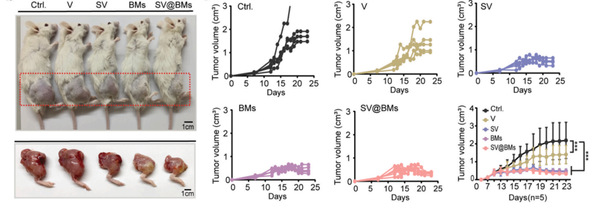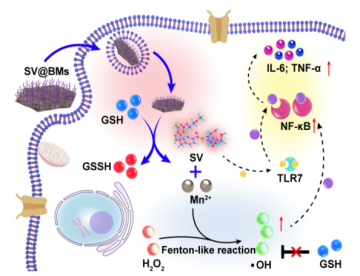Osteosarcoma is the most common primary malignant tumor of bone, mostly seen in children and adolescents. Comprehensive treatment options for osteosarcoma have not evolved significantly in the last 30 years, and there is an urgent need to explore new therapies.
Osteosarcoma is highly malignant, prone to metastasis, and has a poor prognosis. Traditional standard treatment of osteosarcoma relies on surgery and chemotherapy. For patients with early-stage osteosarcoma, standard treatment regimens can achieve a long-term survival rate of more than 60%. However, for patients who have recurrent and metastatic osteosarcoma, standard therapy has limited effects, with a 5-year survival rate of only 20%.
Recently, SLST Assistant Professor Zhang Yifeng's group in collaboration with Shanghai Sixth People's Hospital and China Pharmaceutical University, found that manganese (Mn)-containing nanoparticles stimulates the activation of macrophages in the osteosarcoma tumor microenvironment and strongly inhibits the growth and metastasis of osteosarcoma. The results were published in a paper entitled Manganese immunotherapy for treating osteosarcoma: Glycosylating 1V209 anchored MnO2 nanosheets prompt pro-inflammatory macrophage polarization in the journal Nano Today.
In this study, the researchers attempted to activate immune cells in the tumor microenvironment to treat osteosarcoma. The metal element manganese has shown great potential for immunotherapy by activating NK cells (natural killer cells) and dendritic cells. Meanwhile, macrophages are the most abundant type of immune cells in the tumor microenvironment of osteosarcoma and are closely correlated with the growth and metastasis of osteosarcoma, but the effect of manganese on macrophages is still unknown.
In order to activate multiple immune cells simultaneously, this study loaded manganese dioxide nanoparticles with 1V209, a small molecule agonist of the macrophage activation receptor TLR7, to activate macrophages. In in vitro experiments, drug-treated macrophages exhibited a strong pro-apoptotic effect on osteosarcoma cell lines and significantly inhibited their growth and metastasis in a mouse tumor model. Further studies revealed that Mn-containing nanoparticles elevated the proportion of pro-inflammatory macrophages in mouse tumors and promoted T-cell infiltration in tumors.

Tumor growth curves of treated tumor-bearing mice
The research team proposed that Mn-containing nanoparticles may enter cells and react with intracellular glutathione to release manganese ions, which generate large amounts of reactive oxygen species through Fenton-like reactions and activate NF-κB signaling pathways to promote inflammatory responses in macrophages. This study reveals a novel immunotherapeutic function of manganese and demonstrates that macrophages are one of the key targets for osteosarcoma treatment, laying a foundation for the development of new therapies.

Mechanism of Mn-containing nanoparticles
Liang Chao, master student in Dong Yang's group at the Department of Bone Oncology, Shanghai Sixth People's Hospital, Xiong Naping and Liu Mengfan, master students in Zhang Yifeng's group, are the co-first authors of the paper. Professor Fan Wenpei at China Pharmaceutical University, Professor Zhang Yifeng, and Zhang Zhichang, physician at the Shanghai Sixth People's Hospital are the co-corresponding authors.
**The news article is provided by Prof. Zhang Yifeng

